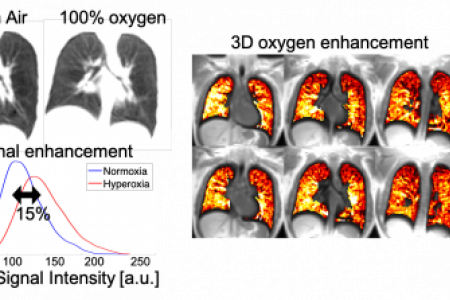Senior Investigator Research Interests
The Laboratory of Imaging Technology Program, led by Dr. Adrienne Campbell-Washburn, focuses on the development of novel MRI technology for cardiac imaging, lung imaging, and MRI-guided cardiovascular catheterization procedures. The lab uses a custom high-performance 0.55T MRI system as well as clinical MRI systems. Specifically, Dr. Campbell-Washburn’s lab develops rapid non-Cartesian imaging methods, inline artifact corrections, and advanced image reconstruction methods which use contemporary computational power integrated into the clinical environment via the Gadgetron (https://github.com/gadgetron/gadgetron). The lab emphasizes translation of new methods to clinical applications through collaboration with interventional cardiologists, imaging cardiologists, pulmonologists, radiologists and critical care physicians.
Videos
| Videos |
|---|
| Multi-section imaging of the lung using T2-weighted MRI (1.1mm x 1.1 mm x 6mm) in a woman with lymphangioleiomyomatosis resulting in innumerable thin walled pulmonary cysts. Adapted from Campbell-Washburn AE, et al, Radiology: Cardiothoracic Imaging https://doi.org/10.1148/ryct.2021200611 (Online ahead of print) |
| ECG-gated spiral in-out bSSFP cine imaging at 0.55T (spiral readout duration = 6.5ms, TR = 8ms). Advanced acquisition strategies increase SNR with limited artifacts at 0.55T. Adapted from Restivo MC, et al, Magn Reson Med, 2020; 84(5):2364-2375. |
| Interactive real-time imaging for MRI-guided cardiovascular catheterization at 0.55T. The bright gadolinium-filled balloon at the tip of the catheter is navigated in different heart chambers. Adapted from Campbell-Washburn et al, Radiology, 2019; 293(2):384-393. |
Clinical Trials and Studies
Meet the Team

Adrienne Campbell-Washburn, Ph.D.
Dr. Adrienne Campbell-Washburn graduated with her B.Sc. in physics from the University of Western Ontario (Canada), and received her PhD in Medical Physics from University College London (UK). She joined NHLBI in 2013 as a postdoctoral fellow in the Laboratory of Cardiovascular Interventions. Dr. Campbell-Washburn was appointed Staff Scientist in 2016 and director of the MR Technology Program in 2017. As of 2020, Dr. Campbell-Washburn became an Earl Stadtman Investigator in NHLBI and the chief of the MRI Technology Program. Dr. Campbell-Washburn is a Junior Fellow of the International Society for Magnetic Resonance in Medicine, a member of the Society for Cardiovascular MRI, and member of the Magnetic Resonance in Medicine editorial board. Her lab has pioneered 0.55T MRI technology for imaging the heart and lungs.
Contact the lab

Rajiv Ramasawmy, Ph.D.

Ahsan Javed, Ph.D.

Felicia Seemann, Ph.D.
Scott Baute, MS, PA-C

Pierre Daude, Ph.D.





